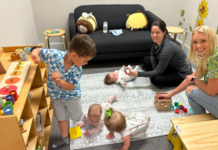 We’ve been homeschooling for eight years now, and as I’ve talked with new homeschool parents over the years, I’m discovering that there are two points where the fear of failure threatens to derail the homeschool process – high school and kindergarten. Parents tend to be okay in the middle, but they get scared of messing up at the end and also at the very beginning – especially over the idea of teaching their child how to read.
We’ve been homeschooling for eight years now, and as I’ve talked with new homeschool parents over the years, I’m discovering that there are two points where the fear of failure threatens to derail the homeschool process – high school and kindergarten. Parents tend to be okay in the middle, but they get scared of messing up at the end and also at the very beginning – especially over the idea of teaching their child how to read.
Makes sense, right? Reading is the most fundamental, foundational skill there is for education, and all future learning comes from the ability to read. What if I mess this up??
But it actually is not that hard to teach a child, especially your child, to read. It takes time and patience and the right materials, but you can do it!
Now, I say that with a couple of footnotes. First, if you already know your child has special needs, by all means, seek out resources and assistance that are appropriate for your child and your situation. What worked for my child will not work for every child, especially those with particular learning struggles. But it is what works for many, even most, neurotypical children, especially if you “start at the very beginning”, as the song “Do, Re, Mi” says.
Let me share what worked for us.
1. A solid phonics program
Reading begins with letter recognition and a solid phonics program. Phonics is the system of correlating sounds with the letters or groups of letters in a language. It teaches the student the “code” of language and then how to “decode” words so they can be understood. Phonics was the way to teach reading for years until the pendulum swung in the direction of whole-word recognition, which teaches instant recognition of a word based on its shape.
Now, reading instruction tends to combine “phonemic awareness” with teaching “sight words” (by the way, if you search for the phrase “phonics vs. sight words”, you will find over 14,000,000 hits). I won’t get into that whole debate here. But, as a South Carolina certified ESOL and ELA instructor, my preference is phonics, with the idea that once a child learns that sound-symbol correspondence, recognition of typical sight words comes naturally.
What does a solid phonics program look like? It can range from extremely simple workbooks to a whole complex system with recordings, flashcards, and other bells and whistles. In the interest of keeping things simple for our budget and our brains, we went with the Abeka kindergarten phonics book, along with their series of readers, and for the first few months of kindergarten, that is the main thing we did.
2. A series of phonetically based readers
As my children learned to sound out their first consonants and short vowel sounds, we added in some additional readers beyond the short, flimsy ones that we got from Abeka. Our preference was the American Language Series, a series of six books beginning with consonant and short vowel words, and gradually getting more complex. Each book has dozens of short, unrelated stories, which allowed us to jump around however we wished, but also had enough stories to keep us occupied for a long time. The stories encourage basic values as well as some Bible-based stories, but are not preachy, and are well-made and durable. My children got such a feeling of accomplishment as they learned to read from a “real book.”
3. Read-aloud time
Children need not only to be taught to read but also to enjoy books. We have read to our children from an early age, exposing them to the ideas, vocabulary, and more advanced syntax of beautiful literature. Whether this is curled up together on the sofa, sitting at the kitchen table, or listening to an audiobook in the car, the benefits of reading aloud to children of all ages is well-established, and there are multiple resources and reading lists for children of all ages. In addition to quality literature, reading aloud is an important way to teach about science, history, and other content area material.
4. Patience
Both of our children began learning to read in kindergarten, continued to grow (sometimes agonizingly slowly) through first grade, and it suddenly clicked by the beginning of second grade. There were moments during first grade for both of them when I began to question if I had done something wrong and if they would ever really get it, but it is important to remember that children learn to read at their own rate. For some, it is very quick. For others, it takes longer, but the difference between “early readers” and “late readers” generally disappears during elementary school.
5. Awareness
One of the biggest advantages of homeschooling is spending time with your child, understanding how he or she learns, and what is and isn’t “normal.” If you notice that your child is struggling with reading or any other skill, do ask questions. Check with other homeschool parents, find a “special needs” social media group, and don’t hesitate to get your child’s vision checked (we found out when our son was in third grade that he has issues tracking – so even though he is completely able to read, he tires out quickly when reading books with more words, fewer pictures, and smaller fonts).
There are some amazing resources available for homeschool parents whose children have special needs. If your child struggles, it does not mean you can’t continue to homeschool. It just means you need to be creative and find what will work.
If you are considering homeschooling your kindergarten child this year, don’t let the fear of teaching reading stop you!!














